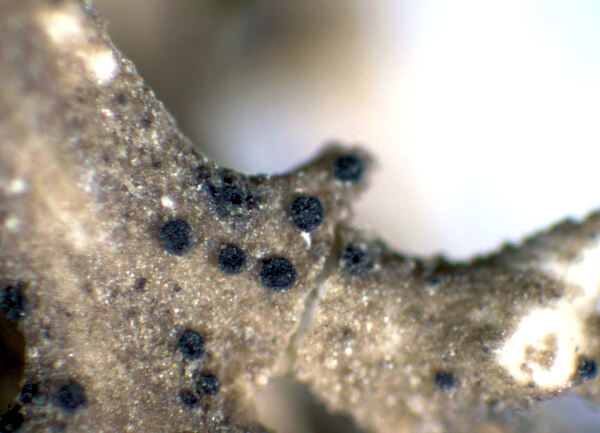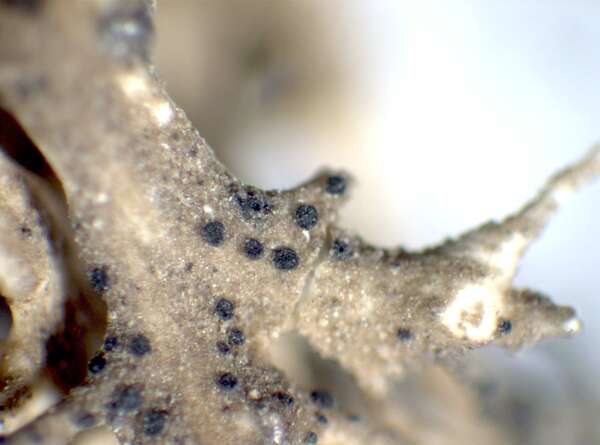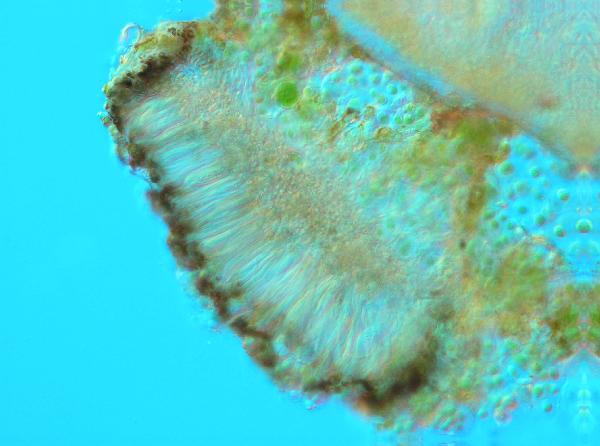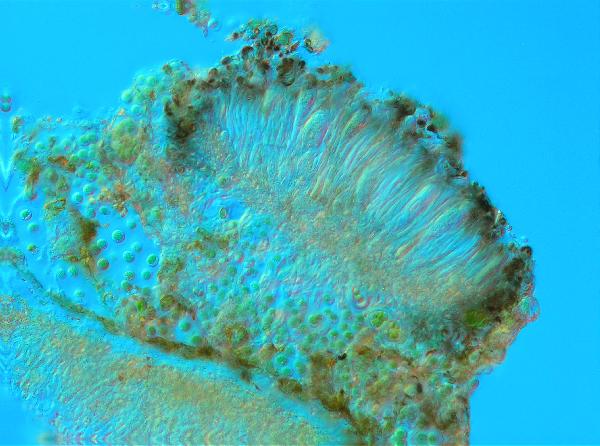Catillaria mediterranea Hafellner
Herzogia, 6: 293, 1982.
Synonyms: Scutula pleiospora Vouaux
Distribution: C - Tosc (Brackel 2015, 2016), Laz (Brackel 2015), Abr (Brackel 2015), Mol (Nimis & Tretiach 1999, Caporale & al. 2008), Sar (Brackel & Berger 2019). S - Bas (Tretiach & Hafellner 1998, Nimis & Tretiach 1999, van den Boom 2002), Cal (Nimis & Puntillo 2003, Puntillo 2011, Brackel & Puntillo 2016), Si (Nimis & al. 1994, Tretiach & Hafellner 1998, Brackel 2008b, Campisi & al. 2020, Brackel & Puntillo 2023).
Description: Thallus mostly inapparent, the hyphae developing inside the thalli of foliose or fruticose lichens, rarely very thin and continuous, appearing as an olive-brown speck. Apothecia lecideine, dark brown to black (the disc brown when wet), epruinose, round to irregular in outline, 0.1-0.2 mm across, with a flat to slightly convex disc and a thin, smooth, raised proper margin. Proper exciple thick, of branched, radiating hyphae coherent in K, dark brown in outer part, straw-coloured within, K-, N-; epithecium brown, K-, N-; hymenium colourless, 40-60 µm high, often inspersed with oil droplets in lower part, I+ strongly blue; paraphyses simple or sparingly branched in upper part, 1.5-2 µm thick at mid-level, the apical cells abruptly swollen, up to 5 µm wide, with a dark brown cap, the pigment located within the cell walls; hypothecium colourless to straw-coloured. Asci 8-16-spored (8-spored and multispored asci usually present in the same apothecium), with a K/I+ blue outer coat and a K/I+ uniformly blue apical dome, Catillaria-type. Ascospores 1-septate, hyaline, ellipsoid to narrowly fusiform, 6-8.5 x 2.5-3.5 µm. Photobiont absent or chlorococcoid. Spot tests: thallus K-, C-, KC-, P-, UV-. Chemistry: without lichen substances.
Note: a mainly Mediterranean lichenicolous lichen (with a very reduced thallus) growing on different foliose and fruticose lichens, e.g. Anaptychia ciliaris, Parmelina spp., Ramalina spp., etc. According to Tretiach & Hafellner (1998) an earlier record from Sardinia (see Nimis 1993: 205) refers to C. servitii; also the record by Garofalo & al. 2010 from Campania probably also refers to that species (see Brackel 2021).
Growth form: Crustose
Substrata: bark
Photobiont: green algae other than Trentepohlia
Reproductive strategy: mainly sexual
paras foliose and fruticose lichens
Commonnes-rarity: (info)
Alpine belt: absent
Subalpine belt: absent
Oromediterranean belt: absent
Montane belt: rare
Submediterranean belt: very rare
Padanian area: absent
Humid submediterranean belt: rare
Humid mediterranean belt: rare
Dry mediterranean belt: absent
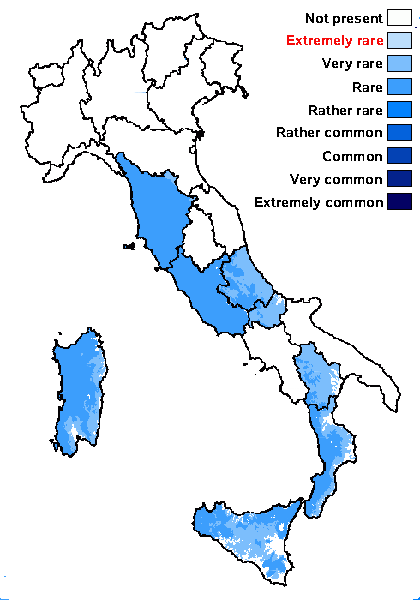
Predictive model
Herbarium samples
Growth form: Crustose
Substrata: bark
Photobiont: green algae other than Trentepohlia
Reproductive strategy: mainly sexual
paras foliose and fruticose lichens
Commonnes-rarity: (info)
Alpine belt: absent
Subalpine belt: absent
Oromediterranean belt: absent
Montane belt: rare
Submediterranean belt: very rare
Padanian area: absent
Humid submediterranean belt: rare
Humid mediterranean belt: rare
Dry mediterranean belt: absent

Predictive model
| Herbarium samples |
 INDEX FUNGORUM
INDEX FUNGORUM
 GBIF
GBIF
